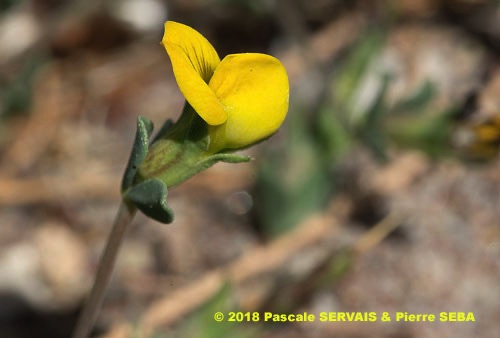
Lotus cytisoides L.
Fam. : Fabaceae
© Pascale SERVAIS & Pierre SEBA, 2018. Tilo Botanica: Flore de Tilos et du Dodécanèse / Flora of Tilos and of the Dodecanese
English translation by Brenda Bradbury, Howard Bradbury and Stéphane Léonard
Plante herbacée, hermaphrodite, rampante ou prostrée, parfois érigée, à tiges cylindriques, ramifiées, couvertes de poils courts, appliqués.
Feuilles alternes, composées imparipennées, généralement à 5 folioles (quelques-unes à 3 folioles), entières, un peu charnues, plus larges dans la partie supérieure, à poils courts appliqués, cunéiformes, de 2 à 10 mm de long, de 2 à 5 mm de large. Feuilles de la base plus petites que les supérieures.
Fleurs à symétrie bilatérale, jaune vif, de 8 à 14 mm de long, solitaires ou groupées par 2, avec à leur base une bractée sessile trifoliée, portées par un pédoncule plus long que la feuille sous-jacente. Corolle papilionacée, à étendard rayé de brun et légèrement échancré, à carène cachée par les ailes et terminée par un bec court, incurvé, légèrement teinté de pourpre foncé. Calice veiné de brun, à poils courts appliqués, à 5 dents inégales, les 2 latérales plus courtes. Ovaire supère.
Fruits, gousses cylindriques, droites ou légèrement arquées, de 20 à 40 mm de long, de 1,8 à 3 mm de diamètre, à bec court, glabres, vertes puis brunes à maturité, à suture marquée de 2 lignes brun rouge.
___________________________
Plant herbaceous, hermaphrodite, trailing or prostrate, sometimes erect. Stems cylindrical, branched, covered in short, appressed hairs.
Leaves alternate, compound imparipinnate, generally with 5 leaflets (some with 3 leaflets), entire, a little fleshy, wider in the upper part, with short, appressed hairs, wedge-shaped, from 2 to 10 mm long, from 2 to 5 mm across. Basal leaves smaller than the higher ones.
Flowers bilaterally symmetrical, bright yellow, from 8 to 14 mm long, solitary or joined together by 2, with at their base a trifoliate, sessile bract, carried by a peduncle longer than the underlying leaf. Papilionaceous corolla, with standard striped of brown and slightly indented, with keel hidden by the wings and finished by a short, curved beak, slightly dark-purple-tinged. Calyx with brown veins, with appressed, short hairs, with 5 unequal teeth, the 2 lateral ones shorter. Ovary superior.
Fruits, pods cylindrical, straight or slightly arched, from 20 to 40 mm long, from 1.8 to 3 mm in diameter, with short beak, glabrous, green then brown at maturity, with suture marked with 2 red brown lines.
Descripteurs / Identifying features
1
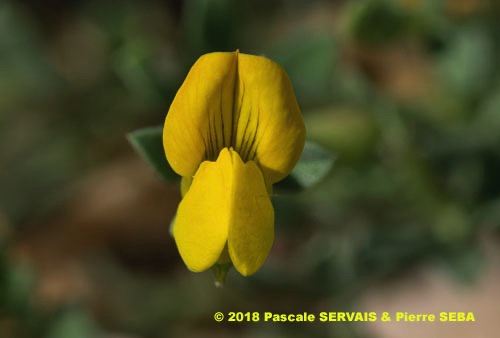
2
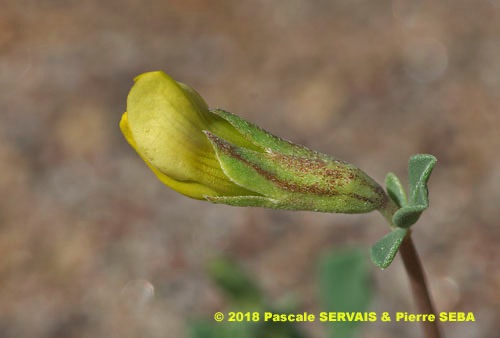
3
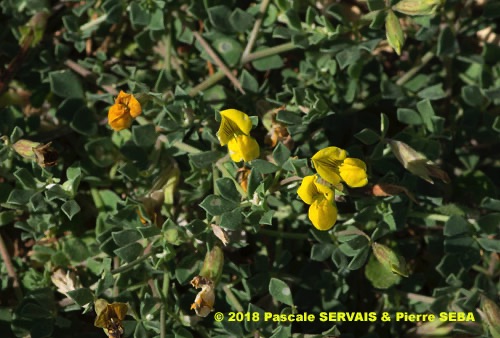
4
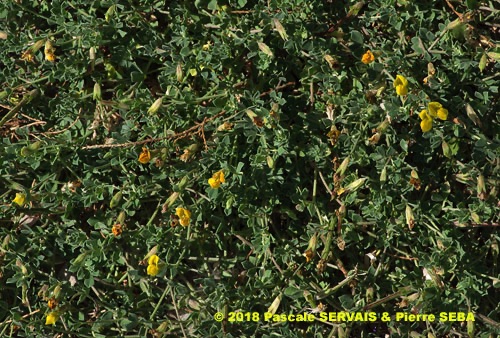
5
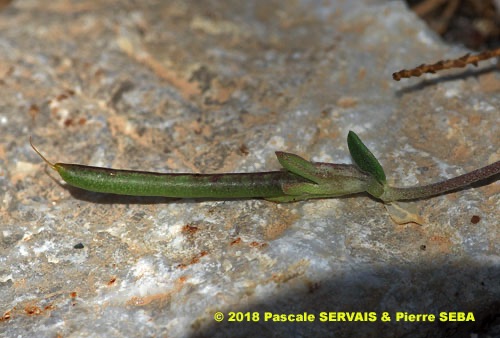
6
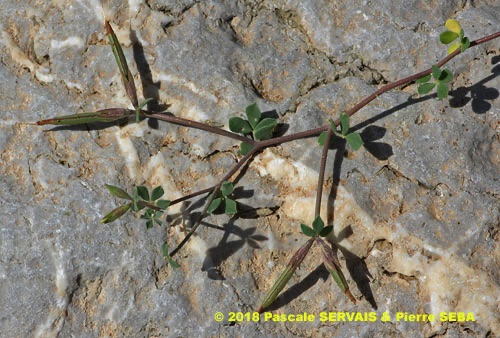
7
Étymologie / Etymology :
Lotus : emprunt du grec ancien λωτός, -οῦ (nom), nom donné par
les Grecs à différentes espèces de plantes.
Cytisoides : emprunt du grec ancien κύτισος, -ου (nom) = le cytise
+ -οειδης (suffixe) = -oïde, qui ressemble à [ < εἶδος, -ους (nom)
= l’apparence, l’aspect ] = qui a l’apparence du cytise, qui ressemble
au cytise.
Lotus : borrowed from Classical Greek λωτός, -οῦ (noun), name given
by the Greeks to various species of plants.
Cytisoides : borrowed from Classical Greek κύτισος, -ου (noun)
= laburnum + -οειδης (suffix) = -oid, resembling [ < εἶδος, -ους (noun)
= appearance, aspect ] = which has the appearance of laburnum,
resembling laburnum.
Synonymes / Synonyms :
Lotus allionii Desv.
Lotus creticus subsp. cytisoides (L.) Arcang.
Lotus cytisoides proles allionii (Desv.) Rouy
Lotus cytisoides subsp. allionii (Desv.) P.Fourn.
Lotus cytisoides subsp. cytisoides
Lotus glaucescens C.Presl
Lotus patens C.Presl
Lotus prostratus Desf.
Lotus secundiflorus Viv.
Noms vernaculaires / Common names :
Nom français / French name :
Lotier faux cytise.
Noms grecs / Greek names :
Λώτος ο κυτισοειδής — Λωτός ο κυτισοειδής.
Nom anglais / English name :
Grey bird’s foot trefoil.
Nom allemand / German name :
Ginster-Hornklee.
Nom espagnol / Spanish name :
Cuernecillo de mar.
Nom italien / Italian name :
Ginestrino delle scogliere.
Habitat :
Sols sableux.
Sandy soils.
Île / Island :
Tilos.
Hauteur / Height range :
De 2 cm à 30 cm.
From 2 cm to 30 cm.
Floraison / Flowering time :
De mars à mai.
From March to May.
Groupe / Classification :
Dicotylédones.
Dicotyledons.
Pérennité / Lifespan :
Vivace.
Perennial.
Description :
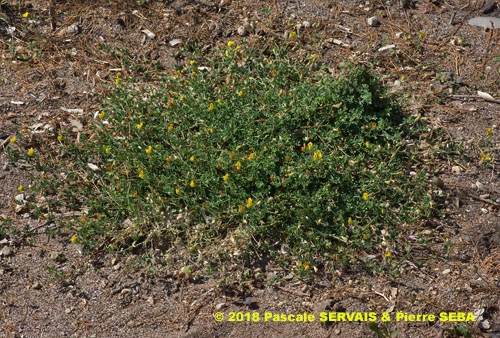
8
Clés dichotomiques et descripteurs distinctifs des 3 espèces / Dichotomous keys and distinctive identifying features of the 3 species
Photo 1 :
Localisation / Location : Tilos, Megalochorio, Erystos
Date : 29/04/2018
GPS : Lat. 36,43323° N / Long. 27,35016° E / Alt. 1 m
Type : Photographie numérique / Digital Photograph (24 mégapixels)
Photo 2 :
Localisation / Location : Tilos, Megalochorio, Erystos
Date : 29/04/2018
GPS : Lat. 36,43323° N / Long. 27,35016° E / Alt. 1 m
Type : Photographie numérique / Digital Photograph (24 mégapixels)
Photo 3 :
Localisation / Location : Tilos, Megalochorio, Erystos
Date : 29/04/2018
GPS : Lat. 36,43323° N / Long. 27,35016° E / Alt. 1 m
Type : Photographie numérique / Digital Photograph (24 mégapixels)
Photo 4 :
Localisation / Location : Tilos, Megalochorio, Erystos
Date : 29/04/2018
GPS : Lat. 36,43323° N / Long. 27,35016° E / Alt. 1 m
Type : Photographie numérique / Digital Photograph (24 mégapixels)
Photo 5 :
Localisation / Location : Tilos, Megalochorio, Erystos
Date : 29/04/2018
GPS : Lat. 36,43323° N / Long. 27,35016° E / Alt. 1 m
Type : Photographie numérique / Digital Photograph (24 mégapixels)
Photo 6 :
Localisation / Location : Tilos, Megalochorio, Erystos
Date : 29/04/2018
GPS : Lat. 36,43323° N / Long. 27,35016° E / Alt. 1 m
Type : Photographie numérique / Digital Photograph (24 mégapixels)
Photo 7 :
Localisation / Location : Tilos, Megalochorio, Erystos
Date : 29/04/2018
GPS : Lat. 36,43323° N / Long. 27,35016° E / Alt. 1 m
Type : Photographie numérique / Digital Photograph (24 mégapixels)
Photo 8 :
Localisation / Location : Tilos, Megalochorio, Erystos
Date : 29/04/2018
GPS : Lat. 36,43323° N / Long. 27,35016° E / Alt. 1 m
Type : Photographie numérique / Digital Photograph (24 mégapixels)

Google Maps
Google Maps
Google Maps
Google Maps
Google Maps
Google Maps
Google Maps
Google Maps